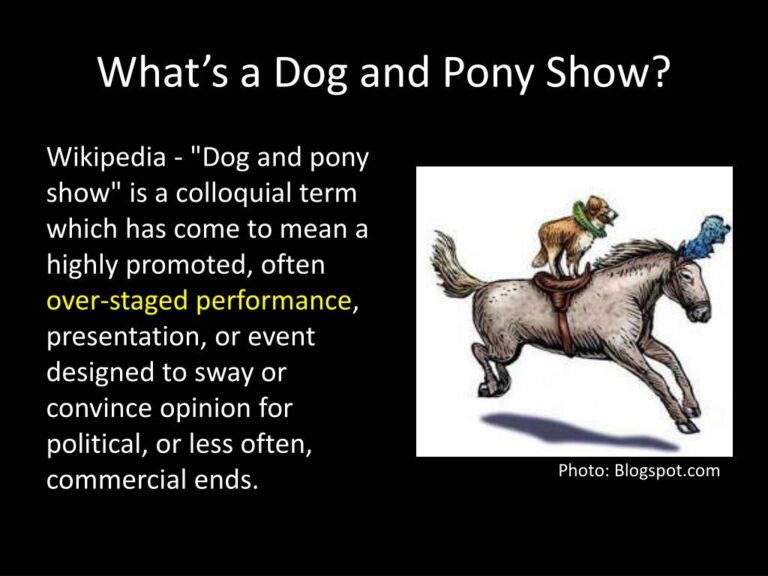Have you ever heard the term “dog and pony show” and wondered what it really means? In the world of business and entertainment, the concept of a dog and pony show is not uncommon. But what exactly does it entail? Let’s delve into the definitions of a dog and pony show to unravel its true essence.
Firstly, defining a “dog and pony show” refers to a presentation or event that is elaborately staged with the intention to impress or divert attention. The term often implies that the spectacle is more about showmanship and distraction rather than genuine substance. Understanding the nuances of this term can provide insights into various contexts where superficiality may overshadow authenticity.
Introduction to the concept of a dog and pony show
A “dog and pony show” is a term that originated in the United States in the late 19th century, referring to a small-scale theatrical performance featuring trained dogs and ponies. Over time, the term has evolved to describe a flashy or elaborate presentation that is designed to impress or distract, often used in a business or political context.
Origin of the Term
The term “dog and pony show” hails from the era when traveling circuses and vaudeville acts were popular entertainment. These shows would often include displays of trained animals such as dogs and ponies to attract audiences.
Usage in Modern Context
In contemporary times, a dog and pony show typically refer to a superficial or insincere presentation aimed at creating a favorable impression without substantial content. It is commonly used to criticize events or presentations that prioritize style over substance.

Origin and history of the term
The term “dog and pony show” originated in the 19th century, where small traveling circuses would often feature acts with trained dogs and ponies. These shows were popular attractions in both rural and urban areas, showcasing entertainment for all ages. Over time, the term evolved to represent an elaborate performance or presentation that is more style than substance, often used in a derogatory manner to describe a superficial or deceptive display.
Evolution of the term
As the entertainment industry progressed, the concept of a dog and pony show moved beyond literal interpretations to signify a performative display intended to distract or divert attention. It also came to symbolize a spectacle designed to impress or entertain without offering significant value or meaningful content.
Modern usage
In contemporary contexts, the term “dog and pony show” is commonly employed in business, politics, and media to describe elaborate presentations or events that prioritize appearance over substance. It is often used to criticize staged performances that lack authenticity or meaningful engagement with the audience.
- Companies may engage in a dog and pony show during product launches to create excitement and buzz, even if the actual product features are limited.
- Politicians might use similar tactics during campaigns to sway public opinion through theatrical displays rather than addressing policy issues directly.
Examples of Dog and Pony Shows in Different Contexts
A dog and pony show, as we define it, refers to a superficial or insincere presentation, often put on for the purpose of impressing or distracting an audience. Let’s explore some real-world examples of such performances in various contexts.
Corporate Setting
In corporate environments, dog and pony shows may take the form of elaborate product launches devoid of real substance, emphasizing style over substance to attract investors and consumers.
Political Arena
Within the political world, dog and pony shows manifest as staged public appearances by politicians, aiming to sway public opinion without addressing crucial issues.
Sales and Marketing
Sales pitches and marketing events often embody the essence of a dog and pony show with exaggerated claims and flashy presentations to entice customers.
Key characteristics of a dog and pony show
A dog and pony show typically involves an elaborate presentation or performance that is intended to impress or distract rather than inform or address substantive issues. In the context of business or politics, it often refers to a flashy display designed to create a favorable impression without delivering meaningful content.
1. Excessive Emphasis on Appearance over Substance
Participants in a dog and pony show may focus extensively on superficial aspects such as visuals, rhetoric, or entertainment value, while neglecting the actual quality or significance of the subject matter being presented. This emphasis on style over substance can deceive audiences.
2. Lack of Transparency
Another characteristic of a dog and pony show is the lack of transparency. Information presented in such shows may be selectively chosen or manipulated to portray a specific narrative, often concealing crucial details or differing viewpoints. This lack of transparency can mislead viewers.
- Participants may use jargon or buzzwords to obfuscate.
- Important data may be omitted or distorted.
- Complex issues are often oversimplified for dramatic effect.
Implications of using the term in various industries
When we delve into the implications of using the term “dog and pony show” across different industries, we uncover a plethora of interesting insights. In the entertainment industry, this term often refers to a flashy, superficial performance to captivate audiences, which can also be observed in corporate settings where elaborate presentations may mask underlying issues.
Corporate World
The corporate world often employs the concept of a dog and pony show during presentations to shareholders or potential investors, emphasizing style over substance. This can lead to short-term gains but may not sustain long-term growth. This trend reflects the emphasis on optics rather than genuine progress.
Political Arena
Similarly, in the political arena, the term is used to describe staged events or speeches aimed at manipulating public perception. Politicians may use elaborate displays to divert attention from key issues.
- Conducting a dog and pony show in politics can sometimes backfire, leading to distrust among constituents.
Comparing a Dog and Pony Show to Other Types of Presentations
When comparing a dog and pony show to other types of presentations, it’s essential to understand the unique characteristics that set them apart. A dog and pony show typically refers to a flashy or elaborate presentation that is more about style than substance, often used to distract or entertain rather than inform. On the other hand, other presentations focus on delivering concise and valuable information to the audience without resorting to gimmicks or theatrics.
Differences in Objectives
A dog and pony show is primarily aimed at captivating the audience’s attention through visual spectacles and performances, whereas traditional presentations prioritize conveying information effectively.
Engagement Levels
While dog and pony shows may provide entertainment value, they may lack depth and fail to engage the audience intellectually. On the contrary, standard presentations aim to stimulate critical thinking and maintain audience interest through informative content.
Frequently Asked Questions
- What is a ‘dog and pony show’?
- A ‘dog and pony show’ is a term used to describe a presentation or event that is extravagant, elaborate, and often theatrical but lacking in real substance or significance.
- Where does the term ‘dog and pony show’ originate from?
- The term ‘dog and pony show’ is believed to have originated from the practice of small traveling circuses in the United States that featured performing dogs and ponies as their main attraction, often used to attract an audience for the main event.
- How is a ‘dog and pony show’ different from a regular presentation?
- A ‘dog and pony show’ differs from a regular presentation in that it is more focused on style over substance, often using flashy visuals or performances to mask a lack of real content or value.
- Why is it important to distinguish a ‘dog and pony show’ from genuine efforts?
- Distinguishing a ‘dog and pony show’ from genuine efforts is important as it allows individuals to see through superficial displays and focus on substance and authenticity in presentations, events, or performances.
Final Thoughts: Understanding the Essence of a Dog and Pony Show
Exploring the depths of what defines a dog and pony show has unveiled a fascinating world of elaborate presentations and flashy displays. These events, often characterized by superficial charm and theatrics, serve as a powerful tool in various facets of society, from politics to business. By dissecting the true meaning of a dog and pony show, we have gained insight into the nuances of performance and persuasion.
In conclusion, a dog and pony show is not merely a spectacle but a strategic approach to captivate and influence audiences. Understanding the intricacies of this concept empowers us to discern between genuine substance and mere showmanship in our interactions. Let us carry forward this knowledge as we navigate through the dynamic realms where appearances often deceive.



